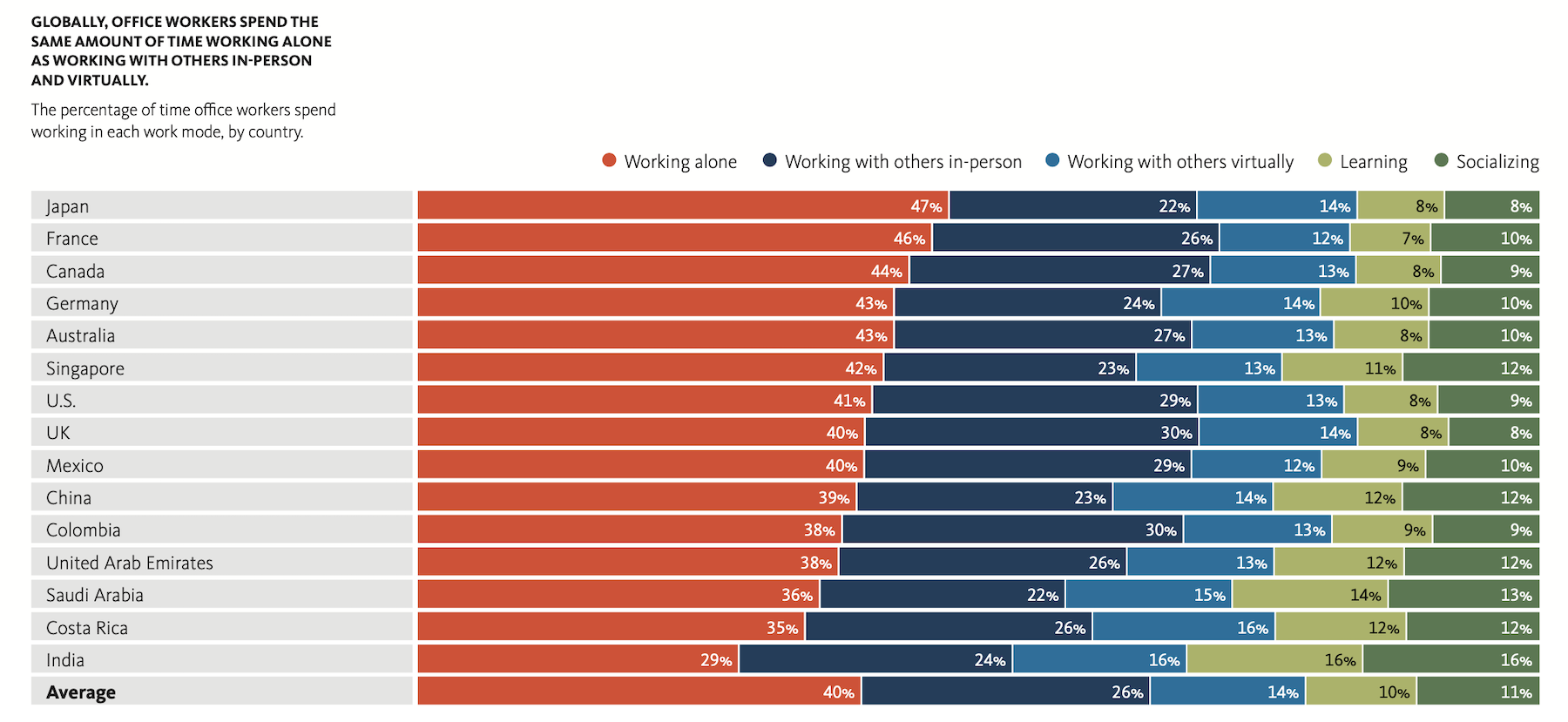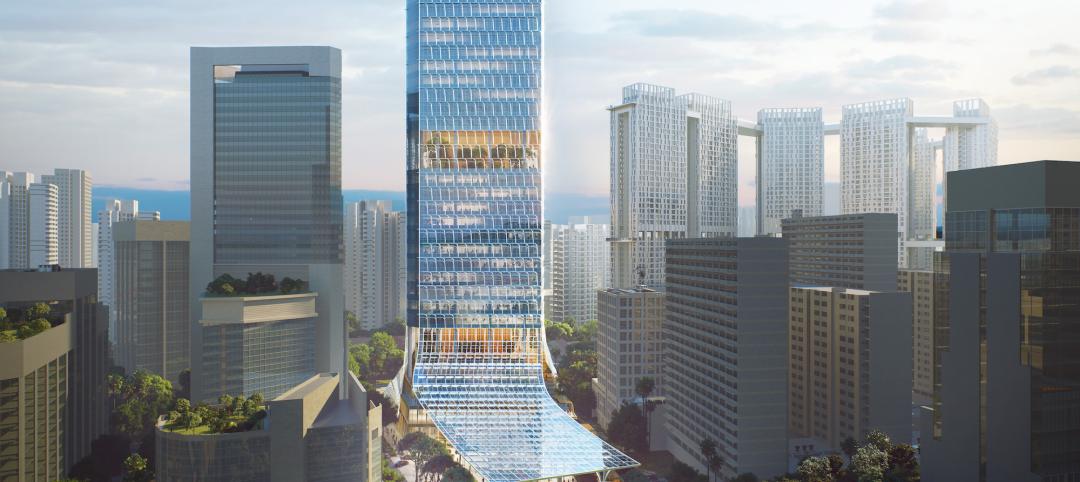For years, AEC firms and their developer clients have worked under the assumption that a good workplace is effective when it fosters working alone, with others in-person and virtually, learning, and socializing.
These factors are foundational as workplace performance indicators. “But having a good workplace is no longer enough,” states The Gensler Research Institute in its Global Workplace Report 2024, which is based on over 16,000 employee responses to a survey conducted in 15 countries and with 10 client industries. (The survey, conducted from October 2023 to January 2024, did not include fulltime remote workers.)
The report contends that employees are seeking different experiences that go beyond functional and effective office spaces, and now include feeling that the space is beautiful, welcoming, and inspires thinking. Within the office, spaces with the greatest impact on performance are innovation hubs, cafés, outdoor areas, and “focus” rooms. Beyond the building itself, exceptional workplaces leverage their surrounding neighborhoods’ amenities and services.
Gensler’s research shows, however, that many workplaces across industries and countries lag in the quality of their workplace experiences.

High-performing employees have more workplace choices
Gensler’s latest study highlights the shift, in gauging an office’s effectiveness, from real estate occupancy to people-centric performance measures, to assess the design impact on how employees work and feel in the workplace, individually, in teams, and as part of a company.

The report defines workplace performance as an average of two composite scores that measure how space supports work and how employees feel about that space. Effectiveness measures factors such as function, layout, and so forth; experience measures factors such as beauty and inspirational feelings.
Global office workers spend half of their typical workweeks in the workplace, 20% of their time at home, and 29% in other locations that might include coworking space. Pre-pandemic, this average was closer to 70% of time in the office. “Now, more than ever, the workplace needs to respond to a wider offering of spaces and experiences,” states the report, adding that employees across the world have unique and individual needs within the office.
The report looks closer at how top performing employees are experiencing their workplaces. The report scores the most-engaged individuals on factors such as how energized and happy they feel while working. Employees with the highest engagement score differ from other workers in the amount of time they spend working alone, learning, and socializing. (The report finds that these employees spend just 36% of their time working alone, versus 44% among the least-engaged employees.)

Nearly all top performers—96%––also say they have control over how they manage their time, versus half of those working in low-performing offices. Gensler emphasizes that “exceptional” workplaces offer their employees choices about where they work within the office. High-performing workplaces offer greater access to spaces for critical work activities, and overall have more work settings to choose from. This empowers the employees to work at the most effective spaces for their tasks.
It's not all about work, either. More than 90% of employees in high-performing workplaces says the office allows them to occasionally unplug from technology. And these workers also tend to use the office more for socializing and having fun.
Amenities add to workplace’s cache
Two-thirds of the workers surveyed describe their company’s office building as “one of the premium, higher-quality” commercial buildings in their areas. Gensler contends that building quality has a direct relationship to workplace quality: high-performing workplaces are twice as likely to be inside high-quality office buildings. These buildings, as often as not, are located in neighborhoods that offer diverse amenities, services, and alternate workspaces. High-performing workplaces, estimates Gensler, have access to 2.6-times as many amenity spaces on-site and 1.6-times as many amenities and services in the neighborhood. “Access to amenities and services appears to make a particular difference,” Gensler states about such “ecosystems” of spaces and experiences.

However, the report also finds that less than one-third of workplaces globally has been redesigned in the last three year, making these workplaces less likely to be able to meet the expectations of young people entering the workforce. “There’s a pressing need for organizations to intentionally rethink office spaces to boost company culture and drive business growth,” says Gensler.
Janet Pogue McLaurin, Gensler’s Global Director of Workplace Research, observes that a great workplace “must not only be a tool to get work done effectively but be intentionally designed for human emotion,” creating experiences that support new ways to work in and outside of the office.
Related Stories
Sustainability | Aug 15, 2023
Carbon management platform offers free carbon emissions assessment for NYC buildings
nZero, developer of a real-time carbon accounting and management platform, is offering free carbon emissions assessments for buildings in New York City. The offer is intended to help building owners prepare for the city’s upcoming Local Law 97 reporting requirements and compliance. This law will soon assess monetary fines for buildings with emissions that are in non-compliance.
Office Buildings | Aug 15, 2023
Amount of office space in U.S. is declining for the first time, says JLL
In what is likely a historic first, the amount of office space in the U.S. is forecast to decline in 2023, according to Jones Lang LaSalle. This would be the first net decline according to data going back to 2000, JLL says, and it’s likely the first decline ever.
Office Buildings | Aug 14, 2023
The programmatic evolution of the lobby
Ian Reves, Managing Director for IA's Atlanta studio, shares how design can shape a lobby into an office mainstay.
Office Buildings | Aug 10, 2023
Bjarke Ingels Group and Skanska to deliver 1550 on the Green, one of the most sustainable buildings in Texas
In downtown Houston, Skanska USA’s 1550 on the Green, a 28-story, 375,000-sf office tower, aims to be one of Texas’ most sustainable buildings. The $225 million project has deployed various sustainable building materials, such as less carbon-intensive cement, to target 60% reduced embodied carbon.
Government Buildings | Aug 7, 2023
Nearly $1 billion earmarked for energy efficiency upgrades to federal buildings
The U.S. General Services Administration (GSA) recently announced plans to use $975 million in Inflation Reduction Act funding for energy efficiency and clean energy upgrades to federal buildings across the country. The investment will impact about 40 million sf, or about 20% of GSA’s federal buildings portfolio.
Market Data | Aug 1, 2023
Nonresidential construction spending increases slightly in June
National nonresidential construction spending increased 0.1% in June, according to an Associated Builders and Contractors analysis of data published today by the U.S. Census Bureau. Spending is up 18% over the past 12 months. On a seasonally adjusted annualized basis, nonresidential spending totaled $1.07 trillion in June.
Office Buildings | Aug 1, 2023
Creating a nurturing environment: The value of a mother’s room in the workplace
Since becoming an architect, Rebecca Martin of Design Collaborative has drawn a mother’s room into numerous projects. But it wasn't until she became a mom that she fully appreciated their importance in the workspace.
Adaptive Reuse | Jul 27, 2023
Number of U.S. adaptive reuse projects jumps to 122,000 from 77,000
The number of adaptive reuse projects in the pipeline grew to a record 122,000 in 2023 from 77,000 registered last year, according to RentCafe’s annual Adaptive Reuse Report. Of the 122,000 apartments currently undergoing conversion, 45,000 are the result of office repurposing, representing 37% of the total, followed by hotels (23% of future projects).
High-rise Construction | Jul 26, 2023
A 33-story Singapore tower aims to reimagine work with restorative, outdoor spaces
Architecture firm NBBJ has unveiled design details for Keppel South Central, a commercial tower in Singapore. The project, which is slated for completion in late 2024, will transform the original Keppel Towers into a 33-story, energy-efficient building that aims to reimagine work by providing restorative spaces and connections to the outdoors.
Multifamily Housing | Jul 25, 2023
San Francisco seeks proposals for adaptive reuse of underutilized downtown office buildings
The City of San Francisco released a Request For Interest to identify office building conversions that city officials could help expedite with zoning changes, regulatory measures, and financial incentives.

















